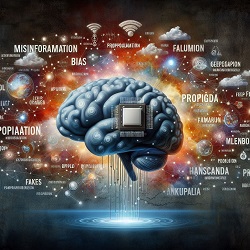 In the ever-evolving landscape of artificial intelligence, one crucial point remains steadfast: AI information can and often does contain inaccurate and unverifiable information. This poses a significant danger in our increasingly AI-driven world. Access to vast quantities of information presents both opportunities and challenges. While large language models offer an impressive information retrieval and synthesis, we must acknowledge a critical limitation:
In the ever-evolving landscape of artificial intelligence, one crucial point remains steadfast: AI information can and often does contain inaccurate and unverifiable information. This poses a significant danger in our increasingly AI-driven world. Access to vast quantities of information presents both opportunities and challenges. While large language models offer an impressive information retrieval and synthesis, we must acknowledge a critical limitation:
AI can and will provide misinformation. This is a call for awareness and caution.
Why is inaccurate information dangerous? The possible scope of this question is far to expansive to address responsibly in this article; however, an answer is still necessary. Firstly, it breeds distrust and undermines the credibility of AI as a reliable information source. Secondly, it can lead to wasted time and effort as users pursue dead-ends based on flawed information. More importantly, it can have real-world consequences, impacting decisions related to healthcare, education, or even financial matters.
Many large language models (LLMs), are still under development and the technology is still immature when it comes to distinguishing definitively between fictional and factual data. Here's why:
Challenges with Distinguishing Fact from Fiction:
- Data Training: LLMs are trained on massive amounts of text and code, which can include both factual and fictional data. This makes it difficult for them to learn the inherent distinctions between the two categories.
- Limited access to curated data sources: Training data for LLMs can be inherently biased, reflecting the biases present in the real world. AI models are trained on massive datasets, but these datasets may not be comprehensive or error-free. This can lead to the model perpetuating existing biases and inaccuracies present in the training data. Put another way, this can lead the model to favor certain types of information over others, potentially skewing its understanding of what constitutes "fact."
- Limited ACCESS to real-time data: AI models are trained on massive amounts of data, but this data isn't always comprehensive or up-to-date. In this case, AIs very often lack direct access to real-time information, which is crucial for providing accurate data.
- Lack of real-time data VERIFICATION: Unlike humans who can access and verify information in real-time, AI models are often limited to the information within their training datasets. This can lead to the dissemination of outdated or inaccurate information.
- Pattern recognition and prediction: AI excels at finding patterns and generating connections within data sets. However, this ability can backfire when encountering incomplete or ambiguous information. The AI will often attempt to fill gaps or "predict" missing details, leading to fabricated responses.
But ultimately, this can be reduced to a single reason...
Lack of Common-Sense Reasoning
LLMs lack the ability to reason about the real world in the same way humans do. This makes it challenging for them to understand the context and implications of information, which is crucial for identifying fiction. AI technology still under development when it comes to fully grasping the nuances of human language and intent. This can lead to misunderstandings and misinterpretations of user queries, resulting in inaccurate or irrelevant responses.
With this is mind, LLMs can be trained and fine-tuned to improve their ability to distinguish between factual and fictional data in several ways:
- Supervised Learning: Providing the LLM with explicitly labeled data sets containing both factual and fictional examples can help it learn the characteristics of each category.
- Heuristics and Rules: Implementing specific rules and heuristics based on known attributes of factual and fictional data can help guide the LLM in its evaluation.
- Contextual Understanding: By incorporating techniques that help the LLM understand the context of information (e.g., source, author, topic), its ability to discern fiction from fact can be improved.
NOTE 1: Even with these advancements, AI can still be fooled by sophisticated fictional content or make mistakes due to limitations in their training data or comprehension.
NOTE 2: None of these three critical elements are within the control of the AI user or consumer.
Therefore, it's crucial to approach all responses provided by LLMs with skepticism:
- Verify information with reliable sources: Don't rely solely on LLM responses for factual information. Always double-check EVERY ASSERTION with established sources.
- Be aware of potential biases: Consider the context in which the information is presented and the potential biases inherent in the training data.
- Use your (human-brain) judgment: Apply your critical thinking skills when evaluating information from any source, including LLMs; keeping in mind that even the human brain can find language, communication, and nuanced meaning difficult.
The potential consequences are dire. Imagine a student relying on AI-generated information for an essay, only to find it riddled with inaccuracies. Or picture a news outlet publishing a misleading story based on AI-provided facts. Or worse, imagine your doctor or lawyer advising you with unverified, hallucinated facts. The implications are and should be horrifying.
By understanding the limitations and utilizing responsible practices, we can ensure that AIs remain valuable tools for information access and exploration, even though they may not always be able to definitively separate fact from fiction. There are strategies to mitigate this issue.
Most importantly:
- Be critical of all information, regardless of the source: Always verify information from multiple sources before accepting it as fact or using it to make "informed" decisions.
- Cross-check information: Never rely solely on single-source data. Always verify information through credible sources like peer-reviewed academic journals or responsible subject-matter experts in the field.
Here are a few tips to minimize fabricated responses when interacting with AI systems:
- Frame your prompts carefully: Avoid open-ended questions like "What if...?" or "Tell me a story about..." as these can easily lead AI to fabricate scenarios or details.
- Provide context and details: The more specific you are in your query, the better chance I have of understanding your intent and providing a relevant and accurate response.
- Report instances of inaccurate information: By flagging inaccurate responses to developers, you help improve the training data and refine the AI model's ability to provide accurate information in the future.
- Be specific and precise: Instead of asking for a broad range of information, provide specific details such as author name, publication date, or key themes. This allows the AI model to focus its search and reduce the possibility of inaccurate results.
- Use quotes and proper punctuation: Quoting specific keywords and phrases can help guide the AI model to relevant information and limit its ability to "fill in the gaps" with fabricated information.
- Focus on facts: When seeking information, distinguish between objective and subjective reasoning. Prioritize factual data points and statistics over opinions or interpretations.
By understanding the limitations of AI and employing these strategies, we can navigate the world of AI-generated information with greater awareness and discernment. Remember, AI is a powerful tool, but it's a tool that needs to be used responsibly and critically.






